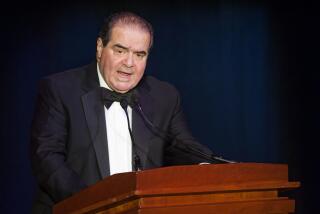The quiet bombshell
- Share via
VIRTUALLY every American knows about Miranda, the famous U.S. Supreme Court decision requiring police officers to inform suspects of their rights. But not even many lawyers know about Blakely vs. Washington. Yet this Supreme Court ruling in 2004 took its place alongside Miranda and others -- including Gideon vs. Wainwright (which required states to provide a lawyer to indigent felony defendants) and Terry vs. Ohio (which allowed police to stop and frisk subjects without probable cause) -- as a precedent that would change the course of American criminal justice.
Although the decision had its roots in a dry and abstract legal question, the case itself centered on a horrific crime. Ralph Blakely Jr., a rancher from the state of Washington, had kidnapped his estranged wife at knifepoint, bound her with duct tape and stuffed her into a box in his pickup truck. At sentencing, the trial judge concluded that Blakely had acted with “deliberate cruelty” -- an “aggravating factor” expressly legislated under Washington’s sentencing statute -- and, as a result, sentenced Blakely to 90 months in prison instead of the standard 53 months.
But the U.S. Supreme Court struck down the sentence, saying that the 6th Amendment right to a jury trial prohibited judges from increasing criminal sentences on the basis of facts that had not been decided by a jury or confessed to by the defendant. Because a jury had not determined beyond a reasonable doubt that Blakely acted with “deliberate cruelty,” the judge could not rely on that fact to increase the sentence. That may not sound like an enormous decision, but it proved revolutionary. Overnight, sentencing rules across the country were thrown into turmoil. Dozens of sentences -- maybe hundreds -- were called into question. If the decision were applied retroactively, how many felons might challenge their sentences?
As many predicted when the Blakely ruling was handed down, the next shoe to drop involved the federal sentencing guidelines for criminal trials -- a massively complex and controversial structure created in the 1980s. Last year, the Supreme Court ruled that this vast system of rules also violated the decision in Blakely. The result, for the last two years, has been a state of suspended animation for federal sentencing. Although the justices didn’t wipe the federal sentencing guidelines off the books, they ruled that, henceforth, the guidelines must be considered “advisory” rather than mandatory.
As the court enters its new session next week, it continues to face the consequences (perhaps unintended) of its watershed Blakely decision.
For instance, in Cunningham vs. California, which is to be argued Oct. 11, the court is being asked to decide whether California’s sentencing laws violate Blakely. The case involves John Cunningham of Contra Costa County, who was convicted on charges of sexually abusing his son. Under California’s sentencing rules, the judge was allowed to sentence him to a “lower,” “medium” or “maximum” sentence. Because the judge thought that the “aggravating” factors outweighed the “mitigating” factors, he sentenced Cunningham to the maximum: 16 years. But because five out of six of those factors had not been determined by a jury, Cunningham has challenged the sentence, saying the California “triad” structure too closely resembles the unconstitutional Washington scheme. At stake is the California sentencing system.
The other big question still facing the court in the wake of the Blakely decision involves not where the ruling applies but when. In Burton vs. Waddington, the court is being asked to decide whether Lonnie Lee Burton, convicted on charges of raping a 15-year-old boy in Indiana in 1991, can have his case reopened under the Blakely ruling.
The question is about the retroactivity of judicial decisions, a very esoteric area of the law. In theory, judges never “make” law but simply interpret or discern its meaning. So if the 6th Amendment means what the high court said in Blakely, it has always meant that, even if earlier judges didn’t notice.
By that theory, all decisions ought to be applied retroactively. But if judges feared that refining or expanding laws would lead to the reopening of vast numbers of old cases, they might choose never to do so. So our legal system has created a strange compromise. Roughly put, a decision can be applied retroactively if it looks like a mere extension of an established rule -- but not if it is the announcement of a new rule. It also can be applied retroactively if the rule seems absolutely fundamental to a fair trial, not a more technical rule.
So in deciding whether to apply Blakely retroactively, the court will tell us just how important or new it thinks its 2004 creation is after all. But this esoteric little piece of legal doctrine has already proved pretty powerful.
More to Read
Sign up for Essential California
The most important California stories and recommendations in your inbox every morning.
You may occasionally receive promotional content from the Los Angeles Times.













